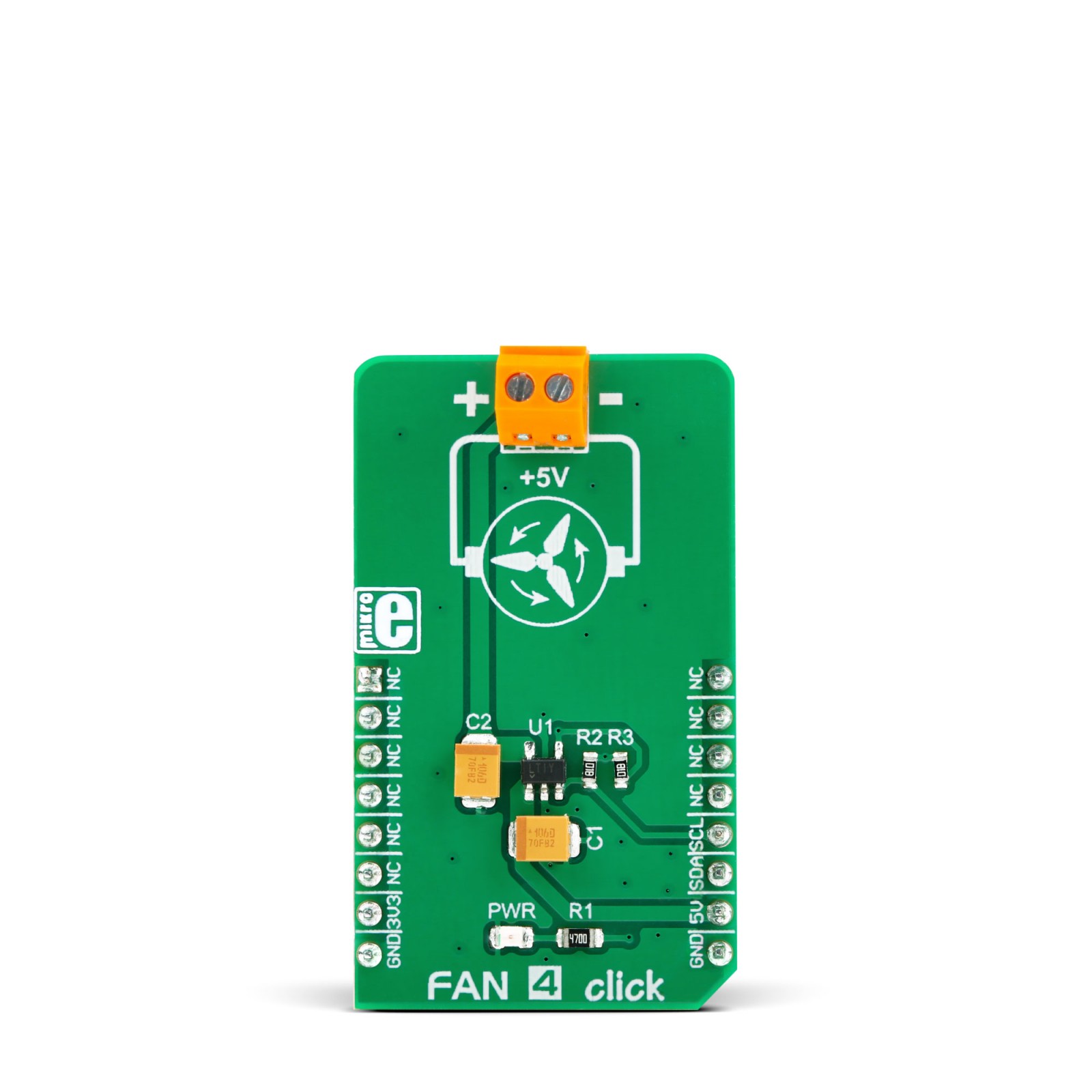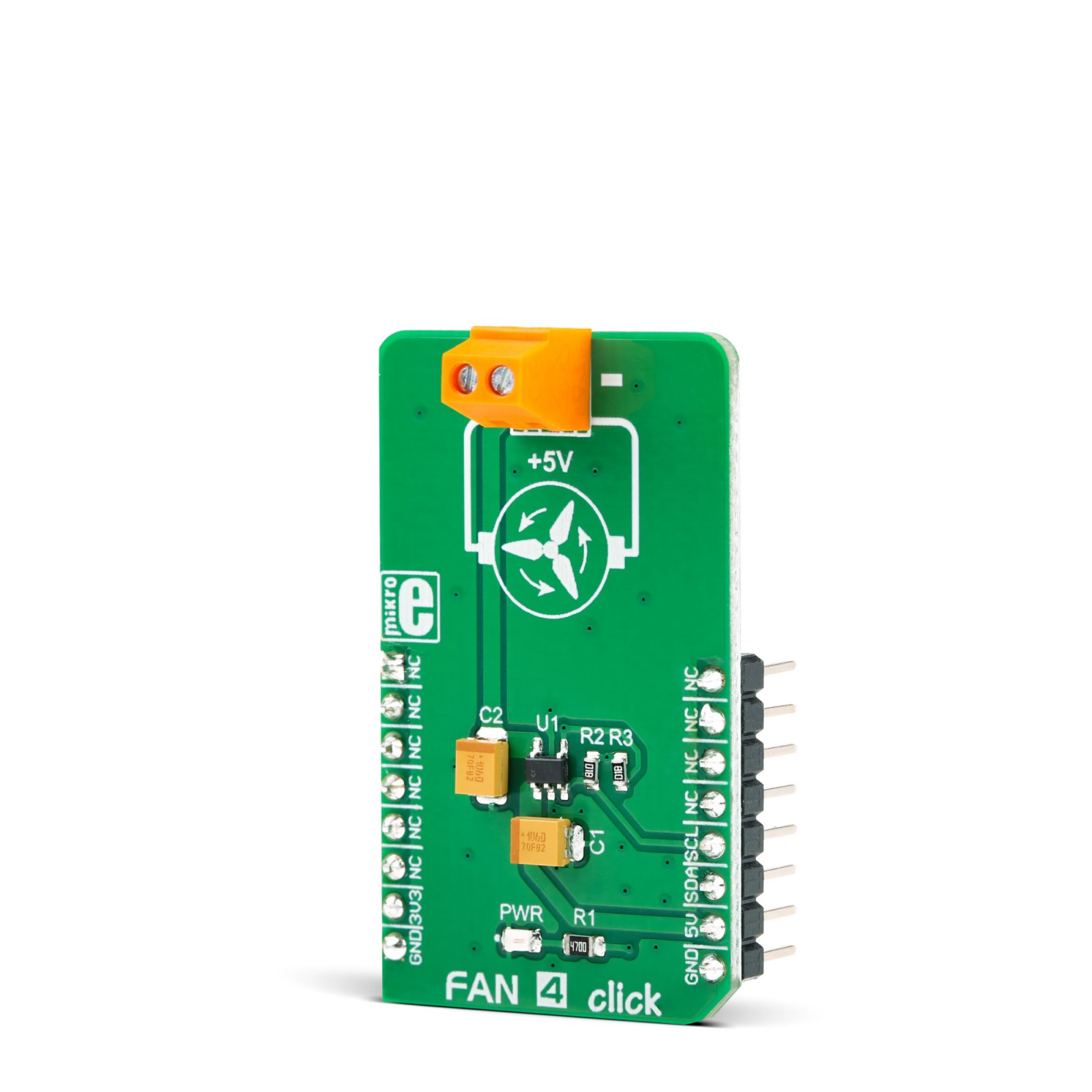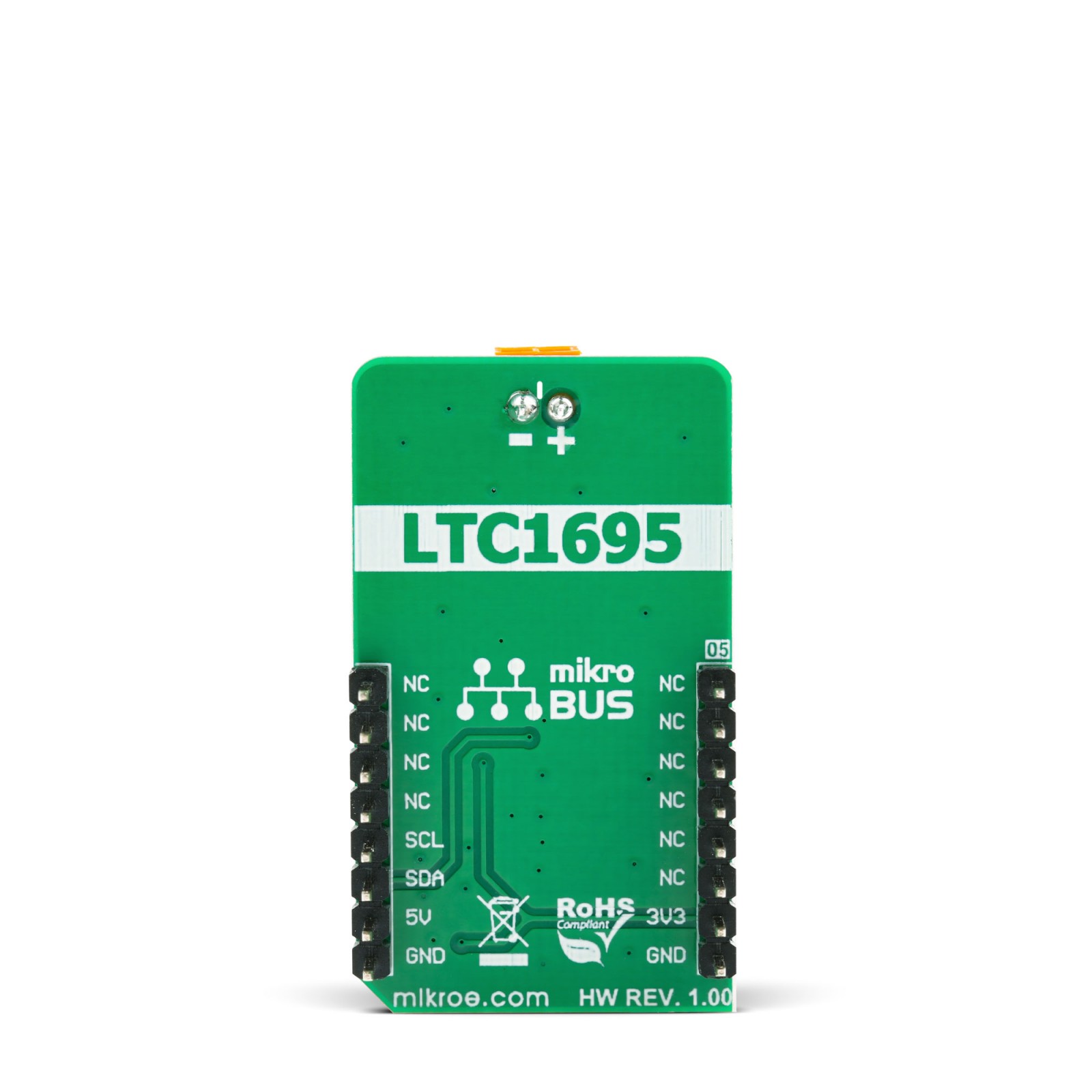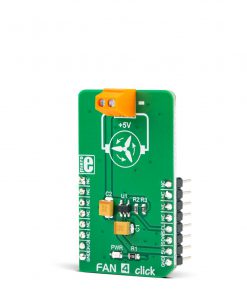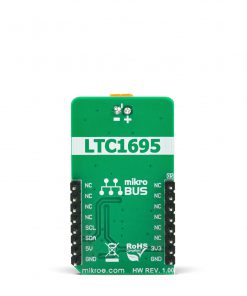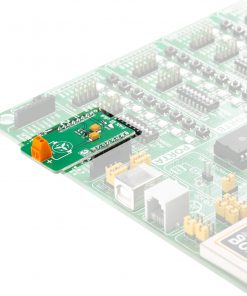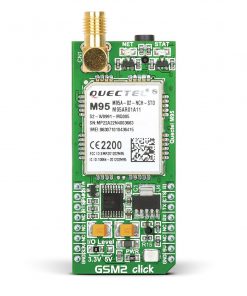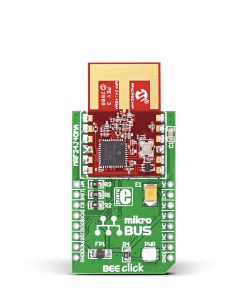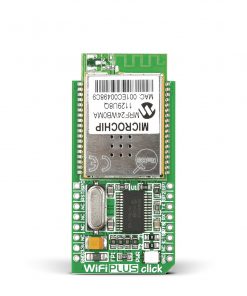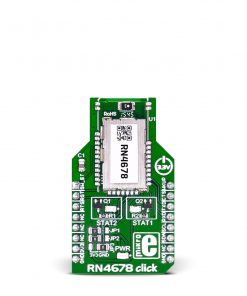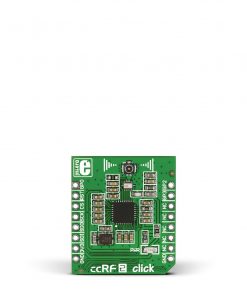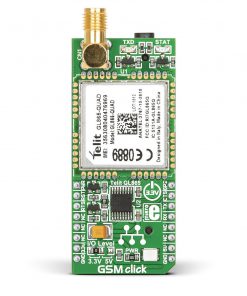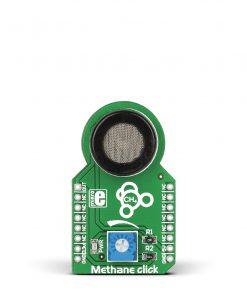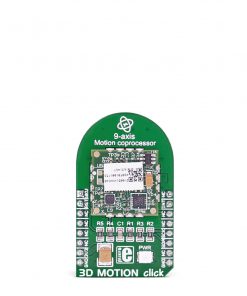Fan 4 Click
R340.00 ex. VAT
Fan 4 click is a very compact, two-wire fan driver. It utilizes an integrated 5V, DC, brushless-motor driver chip. Its output voltage regulation and current limiting capabilities allow the speed control for the two-wire DC brushless motors. The Click board™ uses the LTC1695 IC, which features an integrated 6-bit DAC. The DAC regulates the output voltage in the range from 0 to 4.92V. This IC also has some additional features, such as the maximum output current limiting, and thermal shutdown protection. There is also a startup boost timer which ensures reliable startup of the fan, connected to the output terminal.
Stock: Lead-time applicable.
| 5+ | R323.00 |
| 10+ | R306.00 |
| 15+ | R289.00 |
| 20+ | R278.12 |
This Click board™ uses the I2C communication protocol, which is used to issue a command to the internal 6-bit DAC and set the output voltage. The fault status is also indicated on the I2C bus. The features such as a very compact size of the driver IC, a low number of external components needed, the high efficiency of the integrated PMOS regulator, the current limiting, and the shutdown protection, make Fan 4 click an ideal solution for driving low-power 5V DC brushless motors, such as the ones used for cooling the computer power supplies and laptops, for spot cooling, some general purpose battery operated systems, and more. It can also be used whenever the programmable voltage regulation is required, providing up to 4.92 V and 180 mA to the connected load.
How does it work?
Fan 4 click offers a programmable output voltage regulation, primarily aimed at controlling the speed of the 5V DC brushless fan drivers, which otherwise can’t be controlled by the PWM signal, phase commutation or some other method, leaving only the option to be controlled by changing the power supply voltage. This Click board™ utilizes the LTC1695, an I2C fan speed controller, from Analog Devices. This controller IC uses a very compact SOT23 package case, requires a very low number of additional components, and it is really easy to be controlled by the two-wire I2C bus. This makes it a perfect solution for the fan speed regulator, that can be used for components cooling in various electronic designs. The speed control is very desirable in such applications, but the complexity associated with driving of some other, more advanced types of fan motors that offer speed regulation, often leads to using cheaper, two-wire 5V DC brushless fans, which do not offer any other means to control their speed but to reduce the power supply voltage.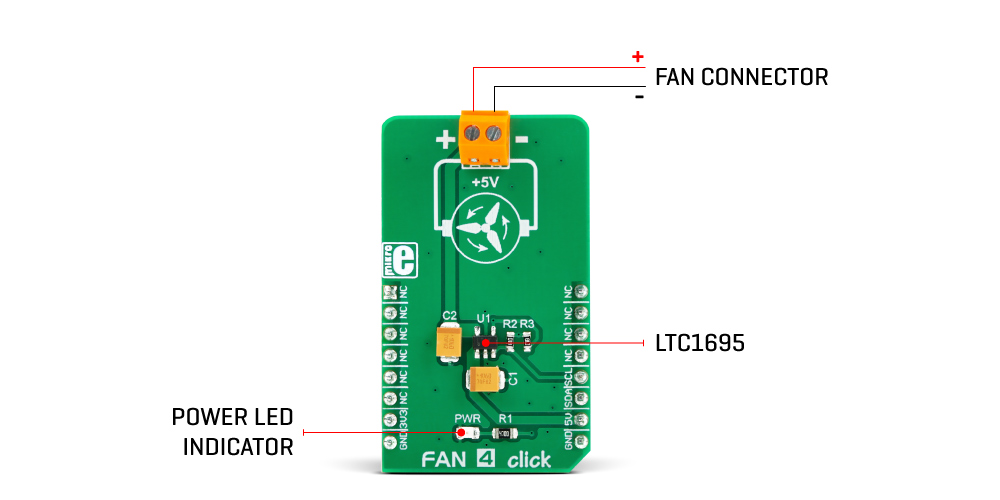
Brushless motors can sometimes exhibit the stall effect if started with the reduced voltage. Although the fan will not rotate, the current will still be consumed, making the stall condition sensing difficult. Therefore, the LTC1695 driver features an internal boost timer, which can be activated by the user, via the I2C command. During the time-out period of the boost timer (250ms), the voltage at the output will be set at the maximum value (4.92V), so the reliable startup sequence of the fan motor is ensured. The LTC1695 datasheet offers some fan models that have been tested with this IC. If there is still a problem with the specific fan model, the firmware on the host MCU can always be utilized to apply a startup boost with an arbitrary interval.
The LTC1965 also features an undervoltage protection (UVLO). If the input voltage stays below 2.9V, the IC will not be enabled, preventing erratic behavior on the output. However, when used with the MikroElektronika development system, the power supply is taken from the regulated power supply unit of the development board.
The internal logic structure of the LTC1695 is also very simple. It only has one 8-bit register. When writing to this register, bits D0 to D5 are used to set the DAC output voltage, while the D6 bit is used to enable the boost timer. Bit D7 is disregarded. When reading out the data, this register reflects the status of the LTC1695 IC, bit D7 indicates overcurrent condition, while the bit D6 indicates thermal shutdown. The remaining six bits are disregarded. During the startup sequence, the internal DAC is set to 0, so there will be no voltage at the output.
The Click board™ has its I2C pins routed to the corresponding pins of the mikroBUS™, and it uses the power from the mikroBUS™ +5V power rail, as already mentioned. The mikroBUS™ is quite capable of supplying the LTC1965 with the maximum amount current it can draw (about 180 mA). The output 2-pole screw terminal allows an external load to be connected. Although the Click board™ is aimed towards driving brushless fan motors, it can also be used as the programmable low drop regulator (LDO), or it can be used as a LED driver.
Specifications
Type
Brushless
Applications
The click can be used whenever a noiseless solution with the variable fan speed is needed, for example – cooling of electronic components with the minimal possible noise produced
On-board modules
LTC1695, a I2C fan speed controller, from Analog Devices (LT division).
Key Features
Fan speed control circuit that allows speed control for 5V DC brushless fans that use only two wires, thermal protection and current limiting, simple to use I2C interface using only a single register, boost timer for reliable fan startup sequence, and more
Interface
I2C
Feature
No ClickID
Compatibility
mikroBUS™
Click board size
M (42.9 x 25.4 mm)
Input Voltage
5V
Pinout diagram
This table shows how the pinout on Fan 4 Click corresponds to the pinout on the mikroBUS™ socket (the latter shown in the two middle columns).
Fan 4 click ratings
| Description | Min | Typ | Max | Unit |
| Output Voltage | 0 | – | 4.922 | V |
| Output Current Limit | – | – | 180 | mA |
Onboard settings and indicators
| Label | Name | Default | Description |
|---|---|---|---|
| LD1 | PWR LED | – | Power LED indicator |
| CN1 | +5V | – | Output screw terminal for connecting the fan |
Software support
We provide a library for the Fan 4 Click on our LibStock page , as well as a demo application (example), developed using MikroElektronika compilers. The demo can run on all the main MikroElektronika development boards.
Library Description
The library performs communication with the Fan 4 Click board. The library can send command with the desired output voltage value to the DAC and can receive report from the DAC to check fault conditions. For more details check documentation.
Key functions:
T_FAN4_RETVAL fan4_setOutput( uint16_t outputVolt, uint8_t boostStartTimer )- Function sets the output voltage on the desired value and turns on/off Boost Start Timer.
T_FAN4_RETVAL fan4_checkDiagnostic( void )- Function checks is Thermal Shutdown or Overcurrent Fault happening and returns a diagnostic state.
Examples description
The application is composed of three sections :
- System Initialization – Initializes peripherals and pins.
- Application Initialization – Initializes I2C interface and puts the DAC voltage value to 0V.
- Application Task – (code snippet) – Checks the uart command (command symbol) and performs the desired command. Possible commands are incrementing and decrementing voltage by desired step, setting the step value, setting the output voltage on minimum and maximum value. To check all commands take look on legend (L).
void applicationTask()
{
if (UART_Rdy_Ptr())
{
rxDat = UART_Rd_Ptr();
switch (rxDat)
{
case '1' :
{
stepVal = _FAN4_DAC_LSB;
mikrobus_logWrite( "Voltage step is 78mV", _LOG_LINE );
break;
}
case '2' :
{
stepVal = _FAN4_DAC_LSB * 2;
mikrobus_logWrite( "Voltage step is 156mV", _LOG_LINE );
break;
}
case '3' :
{
stepVal = _FAN4_DAC_LSB * 3;
mikrobus_logWrite( "Voltage step is 234mV", _LOG_LINE );
break;
}
case '+' :
{
if (voltage <= (_FAN4_MAX_VOLT_SCALE - stepVal))
{
voltage += stepVal;
writeVoltage();
fan4_setOutput( voltage, _FAN4_BOOST_START_TIMER_DIS );
}
else
{
mikrobus_logWrite( "Voltage can't be incremented", _LOG_LINE );
}
break;
}
case '-' :
{
if (voltage >= stepVal)
{
voltage -= stepVal;
writeVoltage();
fan4_setOutput( voltage, _FAN4_BOOST_START_TIMER_DIS );
}
else
{
mikrobus_logWrite( "Voltage can't be decremented", _LOG_LINE );
}
break;
}
case '9' :
{
if (voltage != _FAN4_MAX_VOLT_SCALE)
{
voltage = _FAN4_MAX_VOLT_SCALE;
mikrobus_logWrite( "Voltage is 4922mV", _LOG_LINE );
fan4_setOutput( voltage, _FAN4_BOOST_START_TIMER_DIS );
}
else
{
mikrobus_logWrite( "Voltage is already set on maximum value", _LOG_LINE );
}
break;
}
case '0' :
{
if (voltage != _FAN4_MIN_VOLT_SCALE)
{
voltage = _FAN4_MIN_VOLT_SCALE;
mikrobus_logWrite( "Voltage is 0mV", _LOG_LINE );
fan4_setOutput( voltage, _FAN4_BOOST_START_TIMER_DIS );
}
else
{
mikrobus_logWrite( "Voltage is already set on minimum value", _LOG_LINE );
}
break;
}
case 'L' :
{
writeLegend();
break;
}
default :
{
break;
}
}
}
responseCheck = fan4_checkDiagnostic();
checkResponse();
}
Additional Functions :
- checkResponse – Checks a response from driver functions and shows results on uart.
- writeLegend – Writes all possible commands on uart.
- writeVoltage – Writes current voltage value on uart.
The full application code, and ready to use projects can be found on our LibStock page.
Other mikroE Libraries used in the example:
- Conversions
- I2C
- UART
Additional notes and information
Depending on the development board you are using, you may need USB UART click, USB UART 2 click or RS232 click to connect to your PC, for development systems with no UART to USB interface available on the board. The terminal available in all MikroElektronika compilers, or any other terminal application of your choice, can be used to read the message.
mikroSDK
This click board is supported with mikroSDK - MikroElektronika Software Development Kit. To ensure proper operation of mikroSDK compliant click board demo applications, mikroSDK should be downloaded from the LibStock and installed for the compiler you are using.
For more information about mikroSDK, visit the official page.
Resources
Downloads
| Weight | 19 g |
|---|---|
| Brand | MikroElektronika |

